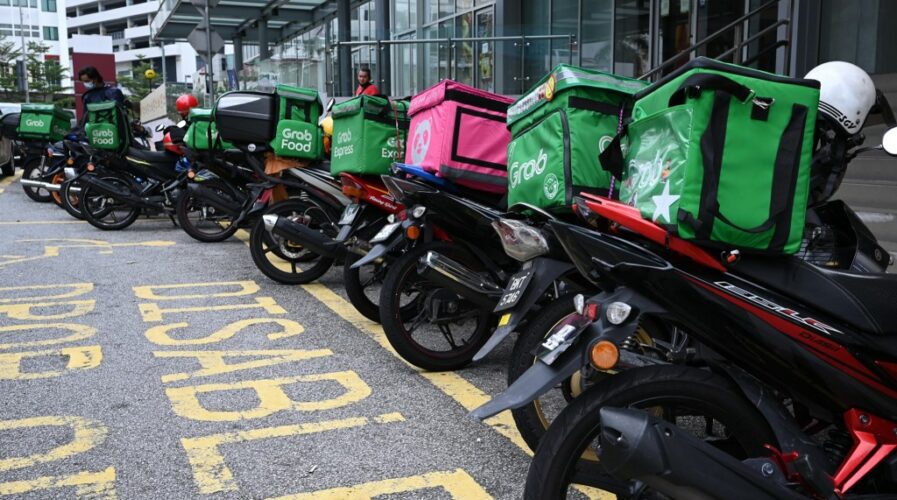
Motorcycles of various food delivery service riders outside a mall in Kuala Lumpur. Source: AFP
Southeast Asia’s big appetite for food delivery
- Southeast Asia has always liked its takeout — but the food delivery tech market has boomed in the last year
- There’s now a competitive and fast-evolving ecosystem of players vying for the biggest slice of the market
Online food delivery has been around as an option in Southeast Asia for a good number of years now. But the ease of smartphone apps, choice of digital payment options, and of course the COVID-19 situation has seen online food delivery adoption skyrocket in the region over the past year.
E-commerce has been picking up in Southeast Asia (SEA) every year, but in the early months of 2020, food and supply scarcity seemed inevitable as people engaged in panic-buying, scooping essentials like toiletries, perishable food items, and frozen foods to see them through the initial uncertainty of the next few weeks or months.
But as most countries in SEA enforced strict lockdowns to contain infections, food delivery services started experiencing tangible spikes in demand. In Malaysia for instance, it was reported that some delivery companies like Foodpanda and Grab Food had recorded more than a 30% increase in orders since a Movement Control Order (MCO) was enacted on March 18 last year.
SEA as a whole food delivery market is expected to grow from US$2 billion in 2018 to an estimated US$8 billion in 2025, according to a Bain report by Google and Singapore’s state investment arm, Temasek. FoodPanda was already a popular food delivery service in Malaysia, the Philippines, and Singapore, but has more recently launched contactless pick-up options, and has added the delivery of groceries and daily essentials to its service repertoire.
The pandemic has caused new online food delivery alternatives to spring up, as the health crisis forced closures of casual restaurants and other physical eateries. Regional giants turned online food delivery services, Grab and Gojek, devoted most of their rider resources to handle the upsurge in online food orders, while their core ride-hailing operations suffered during the lockdown months.
Gojek in fact saw its food delivery business surpass motorbike-hailing in its home market of Indonesia, where it generates around US$2.5 billion in annual transactions. Services like Gojek’s GoFood, Grab Food, and Foodpanda all take a commission of between 15% to 30% for every meal transaction, for providing the platform and connecting hungry consumers with various restaurants along with the riders.
While Gojek and Grab can leverage their established brands in SEA as well as their ‘all-in-one super apps’ to draw users, dedicated online food delivery services like Foodpanda and Europe’s food delivery system, Deliveroo has also staked its claim in the region by charging a premium to provide preferential delivery options.
Speaking of Deliveroo, the express food startup is not only delivering meals but is exploring the concept of ‘cloud kitchens’, AKA a delivery-only kitchen without a dining space, where customers can order from the kitchen to be delivered straight to their front door.
Cloud kitchen chefs usually prepare meals in a central kitchen location before transporting them out, usually using their own delivery personnel rather than a service like Grab Food. Two SEA startups that focused on healthy eating using this model, were launched in the last five years, which is Singapore’s Grain and Malaysia’s Dahmakan.
Like its other online competitors, Dahmakan collects data to understand user preferences, and to improve its quality of service, as Dahmakan CEO and co-founder Jonathan Weins told Tech Wire Asia: “Customers want affordable food. We use order histories and customer data to predict what customers will order in the coming week, which really helps us negotiate grocery orders for the next week. This allows us to lower our costs and pass on the savings to customers.”
“Dahmakan uses an iterative approach in food menu development, powered by feedback from customers. That’s how we find popular dishes and recipes that people love,” Weins continued. “Every day, we make sure our menu has something that will appeal to every palate in the country.”
READ MORE
- Ethical AI: The renewed importance of safeguarding data and customer privacy in Generative AI applications
- How Japan balances AI-driven opportunities with cybersecurity needs
- Deploying SASE: Benchmarking your approach
- Insurance everywhere all at once: the digital transformation of the APAC insurance industry
- Google parent Alphabet eyes HubSpot: A potential acquisition shaping the future of CRM


